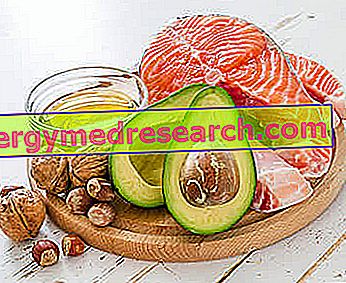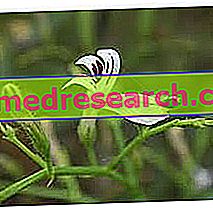Food and omega 3
The nutritional intake of omega 3 is a determining factor for the balance of the diet and to guarantee the general state of health of the organism.
Not all foods have a satisfactory content of omega 3 which, on the other hand, play an indispensable role in the body.
Functions of the omega 3s

- constituents of cell membranes,
- structure the nervous and ocular tissue,
- precursors of anti-inflammatory eicosanoids,
- contrast hypertension and hypertriglyceridemia (with beneficial effects on vascular health),
- participate in maintaining brain function even in old age,
- protect against certain degenerative eye diseases,
- they should reduce the symptoms of rheumatoid arthritis
- improve mood by hindering certain forms of depression
Having said that, it could be deduced that omega 3 deficiency negatively affects body homeostasis, predisposing to various discomforts or pathologies. This is why, in addition to suggesting greater consumption of foods that contain them, some professionals recommend supplementing them with food. However, it would be useless (or wrong) to use this strategy without changing one's food style; ergo, to avoid its deficiency, it is first of all necessary to increase the consumption of foods rich in omega 3. Later we will better understand how to do it, but let us specify immediately that it is a food correction that is anything but simple or trivial; to increase the intake of omega 3, in fact, it is not sufficient to increase the food consumption of the latter, but it is also necessary to evaluate the following factors:
- Type of omega 3: omega 3s are not all the same and some are more useful than others
- Essential fatty acids are not synonymous with omega 3: omega 6s are also essential, which, however, due to their greater presence in foods, are almost never potentially deficient
- Ratio between omega 3 and omega 6; the excess of omega 6 can compromise the metabolic balance or counter the endogenous synthesis of certain omega 3s
- Integrity of omega 3: omega 3 are delicate nutrients and do not always arrive intact on our tables
- Portions of omega 3-rich foods: they are not free, as foods containing more omega 3 also have contraindications.
What are omega 3s?
Omega 3s are lipids. Structurally they appear as carbonaceous chains rich in hydrogen atoms, ending with a methyl group. At the opposite vertex, instead, when they are in free form, they have a hydroxyl group and an oxygen atom; on the other hand they are more often linked (up to three at a time) to a glycerol molecule, to form glycerides (complex lipids). Like omega 6, omega 3 vengoo is defined as polyunsaturated fatty acids, or rather characterized by the presence of double bonds located between the carbon atoms. This characteristic makes them liquid, even at temperatures below 0 ° C, but more delicate and sensitive to cooking, light and peroxidation (rancidity).
It is common opinion that omega 3 are all essential nutrients (which the body does not produce independently). In reality the only truly essential omega 3 is alpha linolenic acid (ALA), from which the human body derives the active metabolites eicosapentaenoic acid (EPA) and docosahexaenoic acid (DHA). Given the precariousness of this last process, some define EPA and DHA conditionally, potentially or semi-essential.
Recall that in nature there are other types of omega 3, which however do not have the same nutritional importance (eg hexadecatrienoic acid, octadecatetraenoic acid, etc.).
Sources of omega 3
From now on we will talk about omega 3 referring only to ALA, EPA and DHA; furthermore, for convenience, we will define all three essential fatty acids.
Alpha linolenic acid, eicosapentaenoic and docosahexaenoic acid do not have the same food sources.
While ALA is predominantly contained in foods of plant origin, EPA and DHA are more abundant in foods of animal origin.
Let's go into more detail.
Foods rich in alpha linolenic acid
Foods rich in alpha linolenic acid are predominantly oilseeds or their seeds. From these we can extract the oil, which is a real fat concentrate. However, these foods often also contain many other different fats, such as omega 6 and omega 9.
Some natural unprocessed foods are rich in alpha linolenic acid, such as: chia, kiwi, perilla, flax, cranberry, camellia, porcelain, sea buckthorn, hemp, walnut, canola and soy.
Secondly, as they are richer in omega 6 or omega 9, they are: almonds, pine nuts, pistachios, pecans, Brazilian nuts, hazelnuts, cashews, sunflower seeds, pumpkin seeds, etc.
Small concentrations of ALA are also present in vegetables and fruit in general.
The foods extracted from these natural sources are still more rich in alpha linolenic acid; for example, the germ of cereals, such as wheat germ, or extraction oils: chia oil, kiwi oil, perilla oil, etc.
Foods rich in eicosapentaenoic and docosahexaenoic acid
Foods rich in eicosapentaenoic and docosahexaenoic acid are mainly: fishery products, especially organisms that inhabit cold waters and blue fish in general, their liver, krill and algae; oil can be extracted from fish liver, krill and algae which, to date, represents the most abundant source of EPA and DHA.
However we must remember that aquatic organisms are potentially subject to environmental pollution from mercury, dioxins, etc; this feature requires to manage their consumption, avoiding to exceed the recommended doses and frequency, preferring less contaminated foods and supplements that have one or more quality certifications.
They are rich in eicosapentaenoic acid and docosahexaenoic "fresh foods, not processed" such as: sardine, mackerel, tuna, bonito, needlefish, lanzardo, horse mackerel, alaccia, herring, cod, salmon, alice, sea lettuce, wakame seaweed etc.
High concentrations of EPA and DHA are also present in dried algae such as nori and kombu (although conservation penalizes the integrity of polyunsaturated fats) and canned fish.
The "foods extracted" and / or "processed" by the aforementioned foods are still MORE rich in alpha linolenic acid; for example, cod liver, salmon roe, mullet roe, roaching fish, sturgeon, bottarga, cod liver oil, salmon oil, etc.
They do not come from real foods and are classified ONLY as supplements: krill oil, spirulina algae, algae oil etc.
In certain countries, especially in the Nordic countries but not only, the meat of cetaceans, the oil made from them and seal oil are also consumed. Note : the hunting of some of these animals is now prohibited.
Summary table of foods rich in omega 3
Foods rich in Omega 3 | |||
Foods rich in ALA | Foods rich in EPA and DHA | ||
Unprocessed natural foods or parts of them | Extracts / supplements | Unprocessed natural foods or parts of them | Processed foods, extracts / supplements |
Chia, kiwi, perilla, flax, cranberry, camellia, porcelain, sea buckthorn, hemp, walnut, canola, soya seeds | Chia seed oil, kiwi oil, perilla oil, linseed oil, cranberry oil, camellia oil, porcelain oil, sea buckthorn oil, hemp oil, walnut oil, canola oil, olive oil soy | Sardine, mackerel, tuna, bonito, needlefish, lard, horse mackerel, alaccia, herring, cod, salmon, alice, sea lettuce, wakame seaweed, cod liver, salmon roe, mullet roe, sturgeon fish, sturgeon | Dried algae such as nori and kombu; canned fish, bottarga, cod liver oil, salmon oil |
Which foods rich in omega 3 prefer?
Difficult to say; the criteria for a healthy and balanced diet are not limited to assessing the concentration of omega 3 in food and many other factors take over. However, considering that ALA, EPA and DHA have partially different functions, as their presence in food is different, it would be appropriate to evaluate the following.
Alpha linolenic acid, present only in foods of vegetable origin, is the only truly essential omega 3; however, in the body it mainly plays the role of precursor of EPA and DHA (non-essential but metabolically active). It is also the most abundant omega 3 in the diet, while the contribution of the other two is limited to "underwater" products.
Considering that the transformation of ALA into EPA and DHA is a process that uses the same enzyme used for switching omega 6 (more abundant in the diet), it is reasonable to assume that this process is NOT sufficient to cover the nutritional requirements of EPA and DHA. Moreover, unlike plant foods, fishing products and algae do not contain higher amounts of omega 6, which facilitates the maintenance of the right ratio between omega 3 and omega 6 in the diet.
For all these reasons, when choosing foods rich in omega 3, it is advisable to use nutritional sources containing EPA and DHA: fish, fish liver, fish oil, fish liver oil, algae, seaweed oil and oil krill.
Portions
Quantity of omega 3 foods and supplements
Foods rich in omega 3 should be taken with elasticity, but not without any criteria.
The fishery products, which belong to the fundamental group of foods, also serve to introduce high biological value proteins, certain B vitamins and specific minerals. The meat of land animals, offal, derivatives and eggs (which belong to the same group) also participate in this function; not only that, the II fundamental group, that of milk and derivatives, also contributes to the same purpose.
For their part, fishery products are also rich in vitamin D and iodine, potentially lacking nutrients in the collective diet; however they can contain, especially large ones, fearsome pollutions such as mercury and dioxins. Furthermore, too much protein can compromise the balance of the diet. This requires:
- Alternate consumption of fish products with meat, cheese and eggs
- Carefully relate the portions and frequency of consumption of highly protein foods (I and II fundamental group of foods), without forgetting that even cereals and legumes can provide considerable quantities of peptides
- Limit the consumption of large fish to "one-off", preferring small creatures, which contain less pollutants
- Consume portions of 150 g referring to fresh foods and 50 g for those preserved
- Regarding supplements, such as fish oil, krill oil or seaweed oil, make sure:
- Who enjoys appropriate certifications such as IFOS (International Fish Oil Standard)
- To keep it carefully
- Do not exceed the dosage, consulting your doctor, pharmacist or following the directions on the label.
Precautions
Avoid excess omega 3
The excess of omega 3, although very rare, can trigger unwanted effects, such as excess peroxidated fat in the circulation. Therefore, for a correct integration with omega 3, it is always a good idea to increase the intake of vitamin E. This antioxidant, usually present as a preservative in over-the-counter products, is instead very abundant in vegetables and oils (the same sources of ALA).
Store the omega 3s
Foods rich in omega 3 and supplements need to be stored properly. We have already said that these lipids fear oxygen and free radicals, heat (cooking) and light.
As regards fresh fishery products, the only way to preserve them accurately is by freezing; in the refrigerator they have a very short time limit. With regards to processed or extracted products, such as bottarga and fish oil, it is advisable to keep them in the dark, in a cool place and in airtight packaging; they can also be placed in the freezer or in the refrigerator. The same applies to vegetable oils and fat-rich grains; many prefer to keep the seeds in glass jars at room temperature, in plain sight, but this does not facilitate their preservation.
The omega 3 are also sensitive to cooking; the oils that are rich in them do NOT lend themselves to cooking and, the food oils (not the supplements like algae, fish and liver oil), should be used as a condiment to be raw.
Foods rich in omega 3 like fish and seeds should be consumed after rapid cooking, not too intense; therefore frying is absolutely not recommended.



